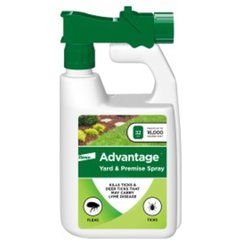Do Fleas Die in the Winter?
Reviewed and updated for accuracy on November 4, 2019 by Dr. Hanie Elfenbein, DVM, PhD
Think fleas are just a warm-weather hazard? Not quite.
Though not as prolific during the winter, external parasites like fleas pose a risk to you and your pet’s health during every season.
Here’s why proper flea and tick prevention must be a year-round priority.
Adult Fleas Are a Small Part of the Flea Life Cycle
Fleas don’t travel from place to place in search of a host. They’re opportunists who find a host, then hold on as long as possible. But it’s not just the adult fleas you have to worry about.
After biting, female fleas will feed on your pet’s blood (unless something disturbs them), mate and start laying eggs within 24 to 36 hours, explains Dr. Jason Drake, a board-certified veterinary parasitologist with Elanco Animal Health.
“One female can lay up to 50 eggs per day for more than three months,” Dr. Drake says. “These eggs are laid on the pet, then fall off into the environment, accumulating in the largest numbers wherever the infested pet spends the most time, such as on bedding or on furniture.”
Flea larvae, which resemble maggots, hatch and feed on semi-digested blood that’s present in adult flea feces. They then form a cocoon and pupate in the environment. “Within the cocoon, the flea larva undergoes metamorphosis and eventually emerges from the cocoon as an adult flea.”
Adult fleas emerge from their cocoons when stimulated by vibration, pressure or carbon dioxide emitted from breath, and when temperatures can sustain their survival, says Dr. Drake.
The life cycle then begins again anew.
Vet Recommended Parasite Control
- Seresto Flea & Tick Collar for Dogs, over 18-lbs, 1 Collar (8-mos. supply)$59.98Chewy Price
- Capstar Flea Oral Treatment for Dogs, over 25 lbs, 6 Tablets$39.98Chewy Price
- Advantage Yard & Premise Spray, 32-fl oz hose-end spray$21.98Chewy Price
- Advantage Flea & Tick Treatment Shampoo for Dogs & Puppies, 12-fl oz bottle$19.48Chewy Price
Can Fleas Survive During the Winter?
“Fleas thrive around 75 degrees Fahrenheit, and it’s around this temperature when they complete their entire life cycle within just a few weeks,” Dr. Drake says.
One adult flea can lay many eggs in this short time. But cold temperatures don’t kill flea eggs—they just slow down the life cycle. Fleas can hatch all through the winter.
What about fleas that are in the pupae stage, waiting inside cocoons?
“They can stay within the cocoon up to 30 weeks at 51.8 degrees Fahrenheit,” says Dr. Drake.
The most common flea species, Ctenocephalides felis, typically overwinters on hosts or in protected areas (carpet, bedding, etc.), provided temperatures are mild.
“No life stage of the flea (egg, larvae, pupae or adult) can survive near-freezing temperatures for very long,” Dr. Drake says. But that doesn’t mean that your pet is safe from fleas.
Adult fleas can be found on pets and wildlife throughout the winter. “Protected areas—such as areas under homes, barns and wildlife dens—can stay warm and humid enough to support flea infestations through the winter,” he says.
“As temperatures rise in the spring, immature stages of fleas are able to survive in the environment, allowing for adult flea populations to rapidly increase,” explains Dr. Drake.
Do I Need to Treat My Pet for Fleas in the Winter?
The short answer is yes. Failing to protect your pet from fleas during winter can be costly to her health. Flea infestations lead to scratching, itching, skin irritations and infections.
By skipping winter flea treatments, you also put your home and yard at risk for developing a flea infestation once warmer weather returns. Flea infestations are difficult to treat and can be very costly.
Keep your pet’s area clean by vacuuming carpets and washing bedding in hot water to kill fleas. Prevention is the real key to reducing your pet’s risk of exposure to fleas.
That’s why choosing a reliable preventive product is critical. “Because of the large numbers of eggs fleas can lay, it is important to use tick and flea products year-round in order to stop fleas before they establish infestations,” Dr. Drake says.
He explains, “Fast-acting products that kill ticks and fleas quickly are important to help prevent eggs from being produced and to reduce the amount of time ticks and fleas can transmit diseases.”
Talk with your veterinarian to figure out the best year-round flea prevention strategy and product for your pet.
By Paula Fitzsimmons
Featured Image: iStock.com/Krisztian Juhasz
Learn More:




